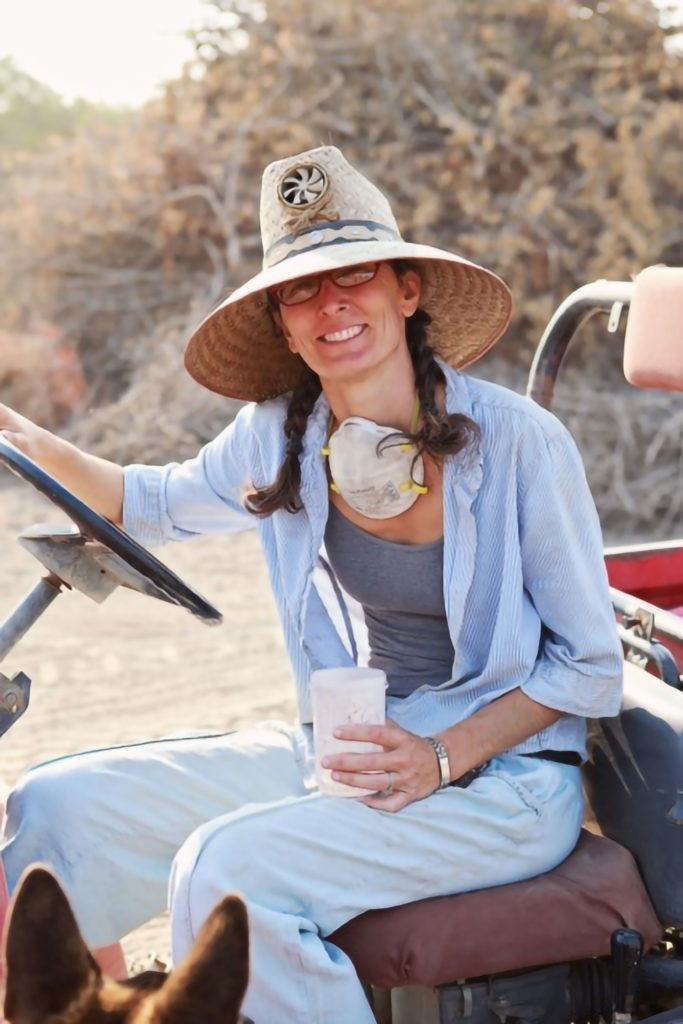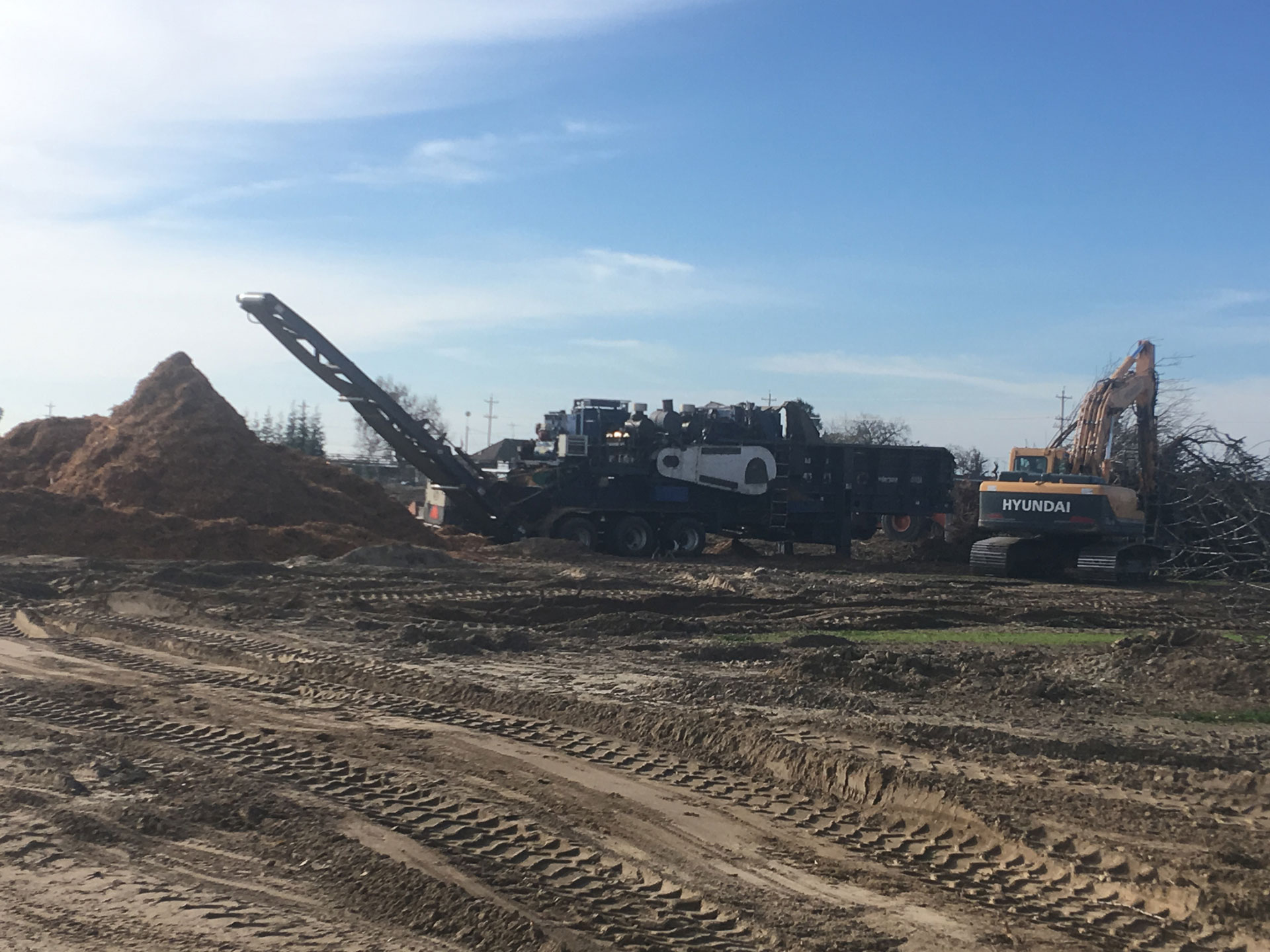Christine Gemperle farms 135 acres of almonds in Stanislaus and Merced counties with her brother Erich. In November 2018, the pair pulled out 20 acres of old trees and decided to try Whole Orchard Recycling (WOR) for the first time on that same 20-acre block.
Christine lives on the land that underwent WOR and had a front row seat to the whole process.
WOR involves grinding trees into small chips then spreading that material across the field and disking it about six inches into the soil. For many growers uncertain of what to do with their old trees, WOR provides a sustainable solution with multiple benefits for soil health as well as yield increases for the new orchard planted on the same ground.
“What amazed me is looking at these massive mountains of chips when they shredded the orchard,” said Christine, who is active on the Almond Board of California’s (ABC) Biomass Workgroup and a member of ABC’s Board of Directors. “Once you start working it into the soil and you take out big pieces, it was like it was never there.”
Rather than rushing to plant new trees, Christine and Erich decided to take their time. They spread chicken manure from the family’s egg operations to add nitrogen to the soil. They ripped the soil before and after plowing the chips in and then hired crews to remove any of the remaining roots. In May 2019, they fumigated to control nematodes, letting the land rest for a month afterward. Finally, they laid out the grids for the new orchard in August, and then installed sprinklers and planted new trees in late September. They intend to plant a soil-building bee forage crop between the rows of trees once rain begins to fall this winter.

On-Farm Benefits of WOR
Multiple research projects funded by the Almond Board of California and executed by the University of California (UC) indicate that Whole Orchard Recycling:
- Increases soil organic matter and soil structure,
- Improves water retention and infiltration,
- Pushes carbon back into the soil, and
- Helps the almond industry move closer to achieving its Almond Orchard 2025 Goal of putting everything grown in the orchard to optimal use by 2025.
“This is one practice that is a win-win for everyone involved,” said Tanya Wood, the Agricultural Affairs specialist for the Almond Board. “It helps to meet water and nitrogen use efficiency. It generates greater yield over time, which means more money in growers’ pockets. And growers can feel good that they’re using a practice that is better for the environment.”
Wood estimates about 20,000 acres of almond trees have been recycled in the past decade.
Depending upon tree density, Wood said an orchard can generate from 30 to 65 tons of organic material per acre. Within that woody biomass is carbon, a food source for microbes that live within the soil.
In addition to feasting on carbon, the microbes also use much of the soil’s available nitrogen, Wood said. For that reason, in the first year after replanting growers should expect to double the amount of nitrogen applied to new orchards on aces where WOR took place. In the second year, as the wood chips continue to break down, they will start to release plant-ready nitrogen into the new trees’ root zone, Wood explained.
Cost Analysis Weighs in WOR’s favor
While Whole Orchard Recycling is not cheap, there are programs to help offset the cost. Plus, as burning restrictions continue to increase and biomass power plants pay less for wood chips, University of California researchers report that the grower’s costs to implement WOR are increasingly favorable compared to the cost of hauling chips to a power plant, particularly when considering long-term yields.
Wood said that pulling trees and grinding them into chips two inches or smaller typically costs about $600 an acre, and then spreading them evenly and plowing them back into the soil can run another $300 to $400 per acre. Growers can find a complete Cost-Benefit Guide on the UC Davis website dedicated entirely to WOR at OrchardRecycling.UCDavis.edu
In an effort to promote orchard recycling and reduce burning, the San Joaquin Valley Air Pollution Control District offers an economic incentive to growers in the form of the Alternative to Open Ag Burning incentive pilot program. Growers can receive anywhere from $300 to $600 per acre, up to $60,000 total, for participating in the program. Those who are interested should call (559) 230-5800 or visit ValleyAir.org for more information. The California Department of Food and Agriculture (CDFA) also offers incentive funding for almond industry members to conduct Whole Orchard Recycling through its Healthy Soils Program. More information about that program may be found at CDFA’s updated Farmer Resource Portal, found at CDFA.CA.gov/FarmerResources/.
As hinted above, researchers predict that over time the cost of WOR can more than pay for itself and set up a grower’s soil for success in helping to produce higher yields.
A study conducted by Brent Holtz, a UC farm advisor in San Joaquin County, and others shows new orchards planted in soil where trees had been recycled can produce up to 1,000 pounds more almonds per acre.[1]
It is important to note, however, that Whole Orchard Recycling may not be the right fit for every situation. For instance, researchers continue to study whether recycling trees suffering from various diseases is a good idea. The concern is whether the disease will be perpetuated in the soil.
Guangwei Huang, the Associate Director of Food Research and Technology for the Almond Board, believes that 20,000 to 30,000 acres of almonds easily could be recycled every year for the next decade with the increased focus on sustainability and zero waste.
“Over the last few years, the topic of Whole Orchard Recycling is resonating more and more with growers,” he said.
For Gemperle, WOR just made sense.
“The idea of burning a whole orchard to me is ridiculous,” she said. “Old trees are such a great resource. And while Whole Orchard Recycling does require some upfront costs, I think over time we’re going to find out even more of its positive impacts.”
[1] Holtz, B.; Browne, G.; Doll, D.; Lampinen, B.; Gaudin, A.; Culumber, M.; Yaghmour, M.; Gordon, P.; and Jahanzad, E. (2018), “Whole orchard recycling and nitrogen considerations in second generation almond orchards” University of California Agriculture and Natural Resources, P. 18 http://ucanr.edu/sites/Nut_Crops/files/285677.pdf











